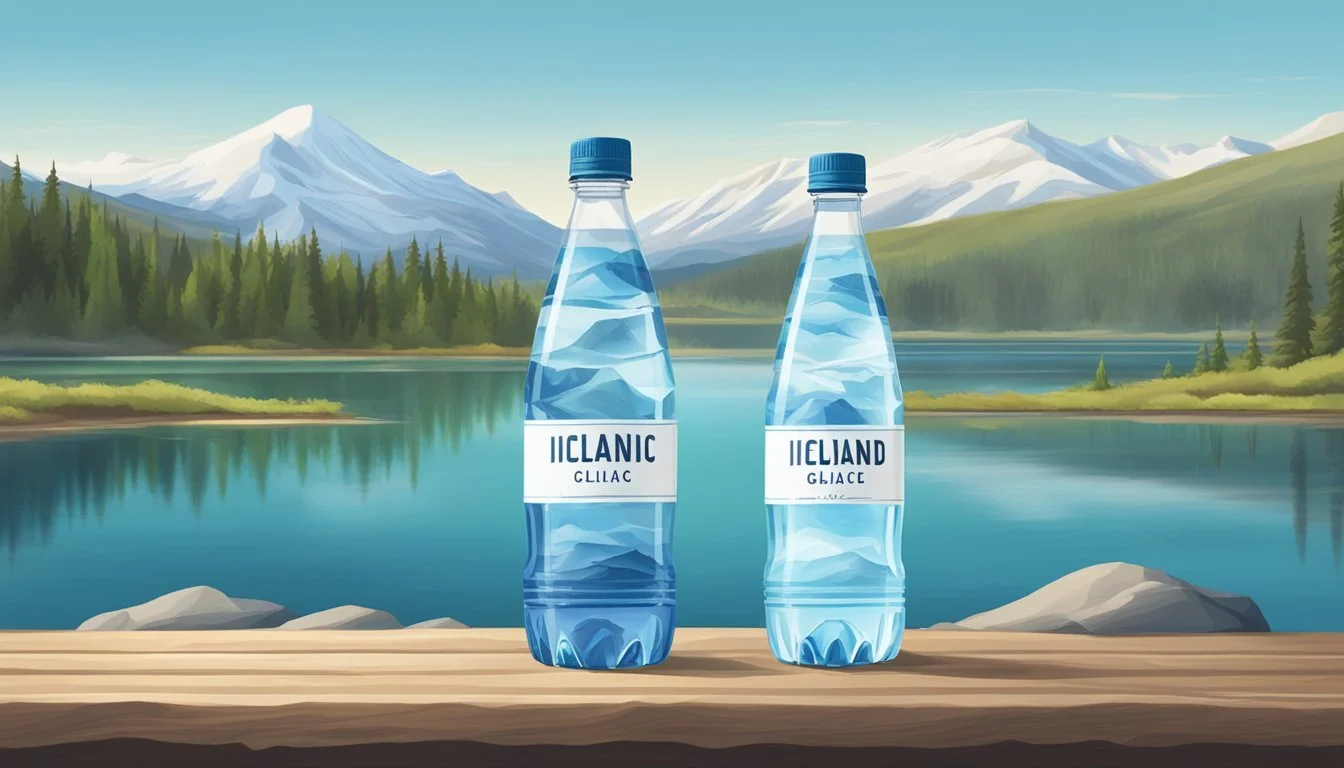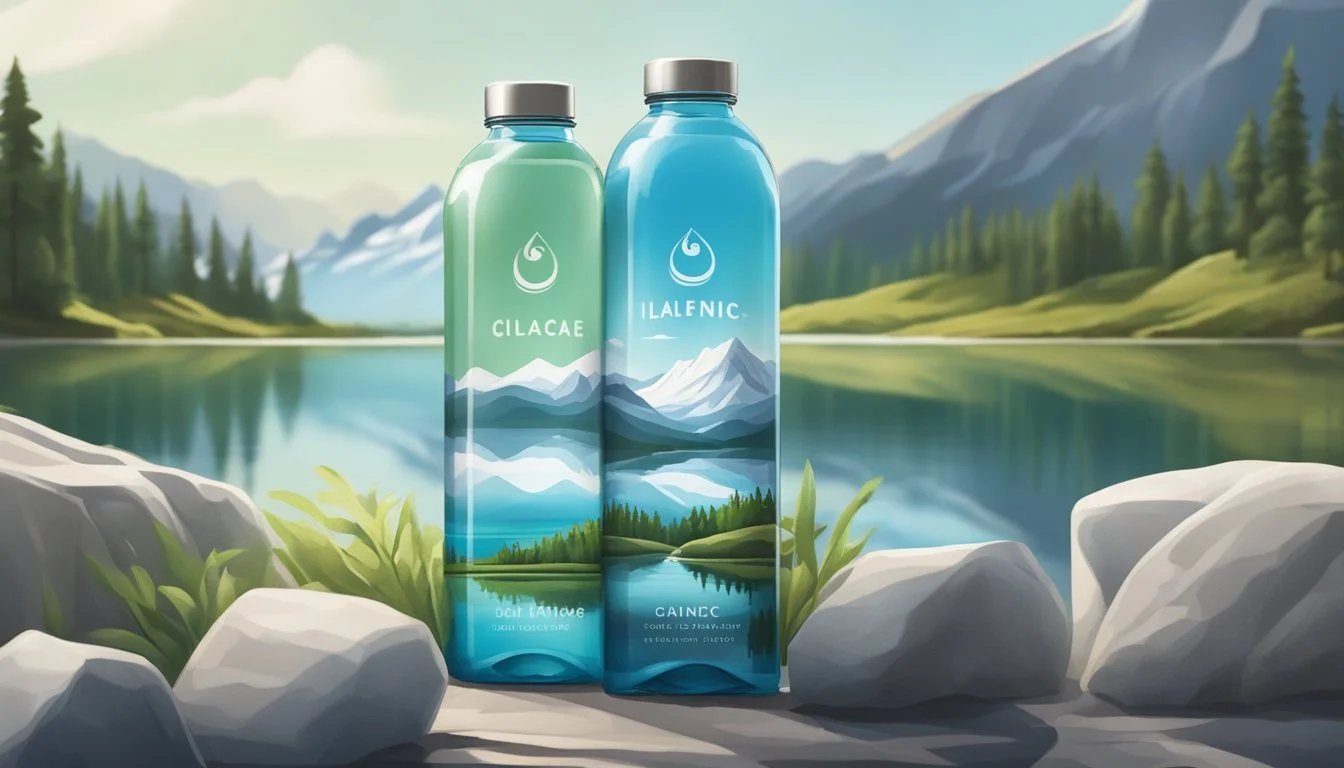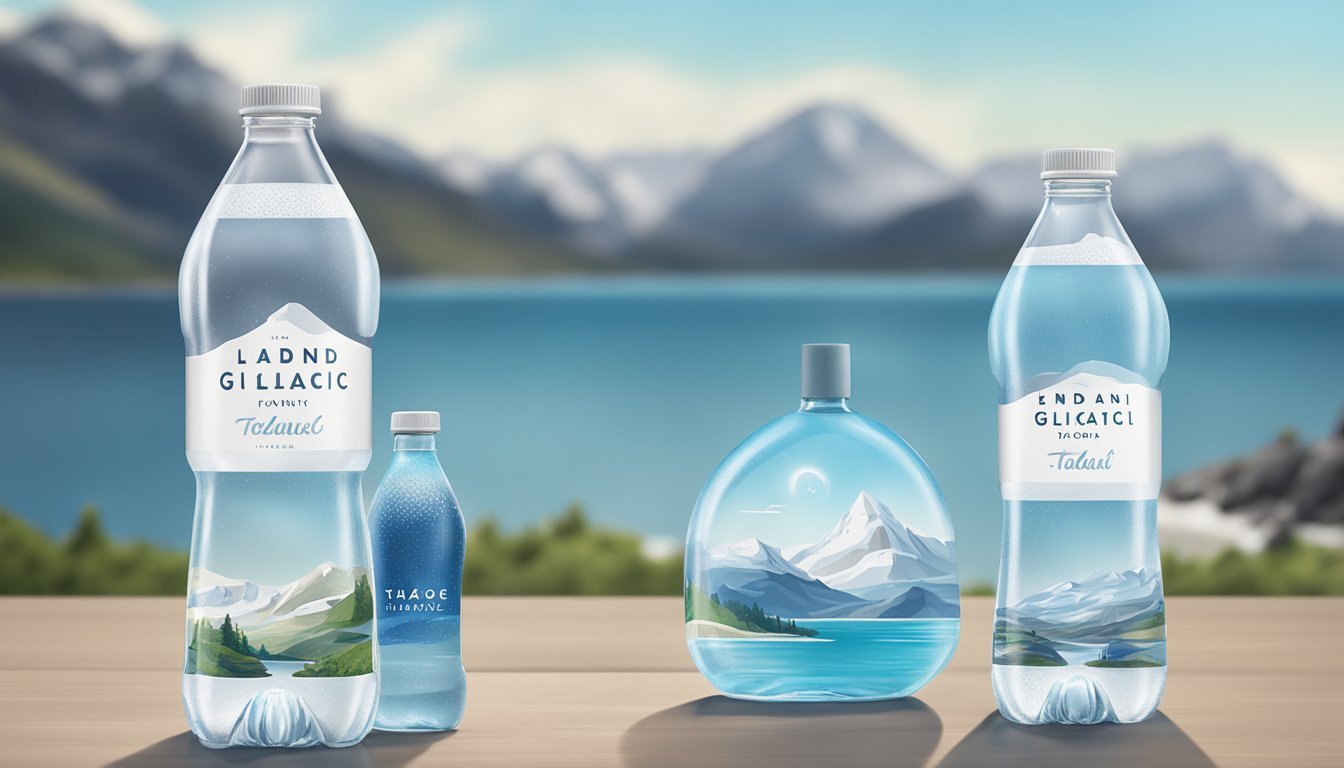Icelandic Glacial vs. Tahoe
Comparing Quality and Taste
Choosing the right bottled water can elevate your hydration experience, and comparing Icelandic Glacial and Tahoe offers fascinating insights into premium water options. Icelandic Glacial is famed for its pristine, glacial-sourced water, which boasts high purity and a crisp, clean taste. Tahoe, on the other hand, markets itself as coming from the pure, protected Sierra Nevada source, known for its refreshing and natural flavor.
Consumers appreciate Icelandic Glacial for its exceptionally clean taste and environmental commitment, using 100% recycled materials for its bottles. Tahoe resonates with those seeking an eco-friendly choice with a balanced mineral profile, often praised for its smooth and refreshing quality.
For those prioritizing taste and purity, Icelandic Glacial stands out as the better choice. However, Tahoe's natural mineral content and sustainability efforts make it a strong contender. Each brand offers distinctive benefits that cater to different preferences, making the choice between them a matter of personal taste and values.
The Essence of Bottled Water
Bottled water provides a convenient and portable hydration solution. It's accompanied by varying quality standards and purity levels, distinguished by water sources and processing methods.
Tahoe water brands often emphasize their pristine source, clear of contaminants. Icelandic Glacial highlights its natural alkalinity and balanced mineral content, offering a unique hydration experience.
Factors to Consider:
Source Quality
Tahoe: Sourced from protected natural reserves, aiming for the purest form.
Icelandic Glacial: Sourced from Iceland's Olfus Spring, known for its low mineral count.
Mineral Content
Minerals like calcium, magnesium, and potassium contribute to taste and health benefits.
Purity Standards
Brands undergo rigorous testing to meet international standards ensuring safety for consumption.
Water Brands Comparison:
Brand Source Mineral Content Purity Standards Tahoe Natural reserves Moderate High Icelandic Glacial Olfus Spring Balanced Very High
Hydration and Taste:
Tahoe offers a fresh, crisp taste thanks to its natural filtration.
Icelandic Glacial boasts a smooth texture with natural alkalinity, enhancing hydration.
Both brands exhibit unique attributes making them preferred choices. The choice depends on individual preferences regarding taste, water source, and mineral content. When choosing bottled water, consider the factors above to find the right fit for your hydration needs.
Understanding the Sources
Both Icelandic Glacial and Tahoe bottled waters boast distinct origins and unique qualities. These differences significantly influence their taste, purity, and environmental impact.
Origin and Selection
Icelandic Glacial is sourced from the Ölfus Spring in Iceland, a naturally replenished spring that has been protected for centuries. The water is collected directly from the spring, ensuring minimal contamination and maintaining its natural purity. Icelandic Glacial markets its water based on the pristine nature of the spring and the surrounding environment.
Tahoe water comes from the mountain ranges around Lake Tahoe. These sources are known for their high elevation and natural filtration processes. The water is typically glacial runoff and snowmelt, which contributes to its purity and distinct mineral composition. Tahoe's selection process focuses on maintaining the natural characteristics of the water by minimizing processing.
Spring Water Explained
Spring water is water that naturally flows to the surface from an underground source. This type of water is often prized for its purity and mineral content, derived from the geological formations through which it travels. Both Icelandic Glacial and Tahoe rely on natural springs for their water.
The Ölfus Spring in Iceland is a prime example of a well-maintained natural water source. It provides a continuous flow of naturally filtered water, renowned for its low mineral content and clean taste. Tahoe’s natural sources similarly benefit from natural filtration through volcanic rock and various geological layers, which contribute to its unique mineral profile. Both brands highlight the pristine nature of their water, offering consumers a natural, refreshing hydration option.
Comparative Analysis of Icelandic Glacial and Tahoe
In this section, we examine the distinct features of Icelandic Glacial and Tahoe bottled waters, focusing on their sources, composition, and unique selling points. Both brands offer distinct advantages based on their origins and purification processes.
Icelandic Glacial: A Spotlight
Icelandic Glacial water is sourced from the Ölfus Spring in Iceland. This spring is known for its naturally high pH of 8.4, making the water alkaline. The water is filtered through layers of lava rock, which imparts a unique mineral composition and purity.
Certifications: Icelandic Glacial is the world's first CarbonNeutral Certified water, a testament to its sustainable practices.
Taste and Composition: The water's high alkalinity provides a distinct and crisp taste, which many consumers find refreshing. The natural filtration through volcanic rocks ensures that the water is free of impurities and rich in minerals.
Tahoe’s Journey in the Bottle
Tahoe bottled water originates from the pristine environment of the Sierra Nevada. Known for its glacial purity, the water undergoes minimal processing to maintain its natural characteristics.
Source: The water is drawn from natural glacial deposits, ensuring a pure and refreshing taste.
Historical Significance: The Sierra Nevada has a long history of glaciation, contributing to the unique mineral profile of Tahoe water.
Taste and Composition: Tahoe's composition is influenced by the regional geology, offering a balanced mineral content that appeals to those seeking a pure, yet naturally mineral-rich water experience.
The distinct sources and unique purification methods of Icelandic Glacial and Tahoe contribute to their individual identities in the bottled water market.
Chemical Composition and Health Implications
The chemical composition of bottled water can significantly impact its health benefits. Comparing the pH levels, mineral content, and potential contaminants in Icelandic Glacial and Tahoe water will provide a clearer picture of their respective qualities.
pH and Alkalinity
The pH level of bottled water affects its taste and potential health benefits. Icelandic Glacial has a pH of approximately 8.4, making it slightly alkaline. This alkalinity can neutralize acidity in the body.
Tahoe water typically has a pH range of 7.0-7.8, which is closer to neutral. Maintaining a balanced pH is crucial as it influences bodily functions and overall well-being. Alkaline water advocates believe it can improve hydration and detoxification, but research is ongoing.
Minerals and Electrolytes
Minerals such as calcium, magnesium, and potassium are essential for various bodily functions. Icelandic Glacial is known for its mineral-rich profile, with notable amounts of calcium and magnesium, contributing to bone health and muscle function. Potassium presents in smaller quantities aids in maintaining electrolyte balance.
Tahoe water also contains these minerals, but the specific concentrations can vary. Consumers often look for Total Dissolved Solids (TDS) to assess overall mineral content. Higher TDS levels generally indicate more minerals, which can be beneficial in moderate amounts.
Addressing Contaminants
Contaminant levels are critical when evaluating bottled water safety. Both Icelandic Glacial and Tahoe water undergo rigorous testing to ensure quality. Icelandic Glacial prides itself on its purity, sourced from a pristine glacial spring.
Tahoe water, sourced from protected areas, also maintains high standards. Nevertheless, the presence of PFAS chemicals and heavy metals can be a concern. Consumer Reports have found varying levels of these contaminants in bottled water brands.
Minimizing exposure to harmful substances is vital. Regular testing and transparency from manufacturers help ensure that consumers receive safe, clean water.
Sensory Experience: Taste and Texture
Both Icelandic Glacial and Tahoe bottled waters offer unique taste profiles influenced by their mineral contents and sources. Examining these aspects reveals how factors like mineral composition and carbonation affect their sensory experience.
The Role of Minerals in Water Taste
Mineral content significantly influences the taste of bottled water. Icelandic Glacial water, sourced from the Olfusa spring in Iceland, is known for its purity, filtering through volcanic rock. This process enriches the water with minerals like silica, giving it a clean, slightly alkaline taste.
Tahoe water, sourced from the Sierra Nevada mountains, boasts a balanced mineral profile, leading to a more neutral taste. The interplay of calcium, magnesium, and other minerals creates a smooth, refreshing mouthfeel.
Still vs. Sparkling
Still and sparkling water offer different sensory experiences. Icelandic Glacial is typically available as still water, emphasizing its pure, unaltered taste. Consumers appreciate its crisp and refreshing profile without additional carbonation.
Tahoe water also predominantly features still options, but there are sparkling variants. Sparkling water undergoes carbonation, adding bubbles that enhance texture and impart a tingling sensation. This can make the experience more invigorating but may mask subtle mineral flavors compared to still water.
The Water Sommelier’s Perspective
Water sommeliers evaluate bottled waters based on their taste, texture, and overall drinking experience. According to experts, Icelandic Glacial is lauded for its pristine, almost imperceptible taste, marked by a touch of silica which adds a smooth mouthfeel. Its purity is a key selling point.
Conversely, Tahoe water is praised for its straightforward, clean flavor profile. Its balanced mineral content appeals to those who prefer a neutral, refreshing drink. Sommeliers highlight the lack of metallic or plastic off-tastes, enhancing its appeal among discerning consumers.
Packaging and Environmental Considerations
Packaging plays a critical role in both consumer convenience and the product's environmental footprint. This section examines both materials and designs, as well as the broader environmental impact of Icelandic Glacial and Tahoe bottled waters.
Bottle Materials and Designs
Icelandic Glacial utilizes BPA-free plastic bottles that are 100% recyclable, highlighting their focus on reducing environmental harm. The company also offers its premium water in glass bottles, catering to a segment of eco-conscious consumers. Natural filtration and the use of high-quality materials set their packaging apart.
Tahoe Water employs a mix of materials, including recyclable plastics and glass. The design is sleek, prioritizing both aesthetics and functionality. Their bottles are durable and feature easy-to-grip designs. BPA-free plastics ensure that the water remains free from potential contaminants.
Environmental Impact
Icelandic Glacial has made strides in minimizing its carbon footprint. The entire bottling process is carbon neutral, supported by their use of renewable energy and eco-friendly practices. Their packaging is designed to be as environmentally friendly as possible, mitigating the negative effects of single-use plastics.
Tahoe Water also prioritizes reducing pollution and landfill waste. They maintain rigorous sustainability standards throughout their production cycle. Although not entirely carbon neutral, Tahoe maintains a robust recycling initiative, encouraging consumers to recycle and reduce waste. The emphasis on using recyclable materials helps decrease their environmental footprint.
Economic and Practical Aspects of Bottled Water
Economic considerations and practical benefits play crucial roles in the choice between Icelandic Glacial and Tahoe bottled waters. Key factors include pricing, availability, and lifestyle impact.
Pricing and Accessibility
Icelandic Glacial, sourced from Iceland, often commands a premium price due to its origin and the associated shipping costs. Tahoe water, sourced locally in the United States, can be more competitively priced.
Pricing varies by location and retailer. In grocery stores, Icelandic Glacial might be priced higher due to its imported status. On the other hand, Tahoe water may be more accessible in regions where it's produced, reducing transportation costs and final pricing.
Both brands have differing levels of accessibility. Icelandic Glacial is found in upscale stores and high-end venues, while Tahoe is typically available in a broader range of retail outlets including grocery stores and convenience stores.
Convenience and Lifestyle Impact
The packaging and distribution channels of both brands cater to different lifestyle needs. Icelandic Glacial, often available in recyclable PET bottles, aligns with luxury and eco-conscious users. Tahoe water, commonly packaged in various sizes including larger jugs, appeals to families and individuals needing convenience.
The location of purchase also brings practical benefits. Icelandic Glacial, with its sleek design and high-end branding, fits well in corporate settings and events. Tahoe, often available in bulk sizes, is practical for daily hydration needs and physical activities.
Convenience stores frequently stock single-serving bottles of both brands, catering to on-the-go consumers. The impact on lifestyle varies; those seeking a more luxurious hydration experience might prefer Icelandic Glacial, whereas Tahoe serves as a reliable and economical option for regular consumption.
Certifications and Regulatory Compliance
Both Icelandic Glacial and Tahoe bottled waters meet stringent health and safety standards and possess notable environmental certifications.
Health and Safety Standards
Icelandic Glacial and Tahoe bottled waters adhere to the regulatory requirements set forth by the FDA and EPA. These regulations ensure the water is free from harmful contaminants and meets high safety and health standards.
Icelandic Glacial water is sourced from a pristine spring in Iceland, guaranteeing minimal exposure to pollutants. Both brands produce BPA-free bottles, which eliminates health risks associated with bisphenol-A, ensuring consumer safety. Regular testing by independent laboratories further certifies the safety of these products.
Environmental Certifications
Icelandic Glacial stands out with its CarbonNeutral certification, indicating carbon neutrality in both product and operations. This is achieved through sustainable practices, including the use of geothermal and hydroelectric energy.
Tahoe also follows environmentally responsible practices, focusing on sustainable water sourcing and eco-friendly packaging. Both companies aim to minimize environmental footprints and comply with international environmental guidelines.
Icelandic Glacial's use of 100% recyclable materials and commitment to renewable energy makes it a leader in environmental stewardship. These efforts significantly reduce their impact on natural resources and ecosystems.
Technological Advancements in Production
Icelandic Glacial and Tahoe leverage cutting-edge technologies to ensure the purity of their water and maintain sustainable bottling practices.
Filtration Techniques and Purity
Icelandic Glacial sources its water from the Olfusa spring in Iceland. The water undergoes a filtration process through volcanic rock, which naturally filters and purifies it. This results in water with a balanced mineral content, including calcium, magnesium, and potassium.
Tahoe, on the other hand, uses modern filtration systems to minimize impurities and enhance mineral balance. These advanced filtration techniques ensure the water remains pure and crisp, meeting high-quality standards. Both brands prioritize purity by bottling the water at the source, reducing contamination risks.
Sustainability in Bottling
Icelandic Glacial stands out by powering its operations with geothermal and hydroelectric energy. Their commitment to sustainability is evident in their certification as a CarbonNeutral company. This eco-friendly approach reduces their carbon footprint and promotes long-term environmental stewardship.
Tahoe also adopts sustainable practices, focusing on renewable energy sources for production. They emphasize reducing waste and improving energy efficiency, making their bottling process more eco-friendly. Both companies recognize the importance of sustainability, implementing measures that contribute to a healthier planet while delivering high-quality bottled water.
The Brand Narratives
A bottled water's brand narrative significantly shapes its market position and consumer loyalty. Icelandic Glacial and Tahoe have distinct identities crafted through their marketing strategies and how consumers perceive them.
Marketing Strategies and Brand Image
Icelandic Glacial emphasizes its origins. Sourced from Iceland’s Ölfus Spring, it highlights purity and sustainability. The water is marketed for its high pH level and environmental commitments.
Tagline: "Drink Pure, Think Pure."
Its branding reflects Iceland’s pristine landscapes, often showcasing its volcanic rock filtration process. This approach appeals to eco-conscious consumers.
Tahoe, while less known globally, markets its water as premium, locally sourced from the Sierra Nevada region. The emphasis is on natural filtration and the pristine nature of the source.
Tagline: "Purely Sierra."
The brand imagery revolves around the vast, untouched wilderness of Lake Tahoe, appealing to those who appreciate local craftsmanship and natural quality.
Consumer Perception and Trust
Consumers of Icelandic Glacial appreciate its clean taste and the brand's dedication to sustainability. The company has garnered loyalty from eco-aware individuals who value its environmental efforts.
Despite its premium positioning, the water remains accessible to a broad audience. Reviews highlight the refreshing taste and consistent quality.
Tahoe is trusted for its commitment to quality and local sourcing. It resonates with those who support regional products and value transparency about water sources.
Consumers frequently mention the fresh, crisp taste and the brand's straightforward approach, which builds trust. While it may not have the same global reach as Icelandic Glacial, Tahoe holds a strong presence in its local market.
More About Icelandic Glacial
Acqua Panna vs Icelandic Glacial: Which Bottled Water is Better?
Aquafina vs Icelandic Glacial: Which Bottled Water is Better?
Arrowhead vs Icelandic Glacial: Which Bottled Water is Better?
Boxed Water vs Icelandic Glacial: Which Bottled Water is Better?
Core Hydration vs Icelandic Glacial: Which Bottled Water is Better?
Deer Park vs Icelandic Glacial: Which Bottled Water is Better?
Essentia vs Icelandic Glacial: Which Bottled Water is Better?
Eternal vs Icelandic Glacial: Which Bottled Water is Better?
Ice Mountain vs Icelandic Glacial: Which Bottled Water is Better?
Icelandic Glacial vs 1907water: Which Bottled Water is Better?
Icelandic Glacial vs 7-Select: Which Bottled Water is Better?
Icelandic Glacial vs Alkaline88: Which Bottled Water is Better?
Icelandic Glacial vs Antipodes: Which Bottled Water is Better?
Icelandic Glacial vs Aqua Carpatica: Which Bottled Water is Better?
Icelandic Glacial vs Big Chill: Which Bottled Water is Better?
Icelandic Glacial vs Big Win: Which Bottled Water is Better?
Icelandic Glacial vs BodyArmor: Which Bottled Water is Better?
Icelandic Glacial vs Cascade Mountain: Which Bottled Water is Better?
Icelandic Glacial vs Castle Rock: Which Bottled Water is Better?
Icelandic Glacial vs CBD Living: Which Bottled Water is Better?
Icelandic Glacial vs Crystal Geyser: Which Bottled Water is Better?
Icelandic Glacial vs Crystal Lake: Which Bottled Water is Better?
Icelandic Glacial vs Erewhon: Which Bottled Water is Better?
Icelandic Glacial vs Essence pH10: Which Bottled Water is Better?
Icelandic Glacial vs Hawaii Volcanic: Which Bottled Water is Better?
Icelandic Glacial vs Hawaiian Springs: Which Bottled Water is Better?
Icelandic Glacial vs Just Water: Which Bottled Water is Better?
Icelandic Glacial vs Kirkland Signature: Which Bottled Water is Better?
Icelandic Glacial vs LIFEWTR: Which Bottled Water is Better?
Icelandic Glacial vs Liquid Death: Which Bottled Water is Better?
Icelandic Glacial vs Mananalu: Which Bottled Water is Better?
Icelandic Glacial vs Mountain Valley Spring Water: Which Bottled Water is Better?
Icelandic Glacial vs Nestle Pure Life: Which Bottled Water is Better?
Icelandic Glacial vs Open Water: Which Bottled Water is Better?
Icelandic Glacial vs Perrier: Which Bottled Water is Better?
Icelandic Glacial vs Poland Spring: Which Bottled Water is Better?
Icelandic Glacial vs Proud Source: Which Bottled Water is Better?
Icelandic Glacial vs Pure Life: Which Bottled Water is Better?
Icelandic Glacial vs Purely Sedona: Which Bottled Water is Better?
Icelandic Glacial vs Refreshe: Which Bottled Water is Better?
Icelandic Glacial vs Richard's Rainwater: Which Bottled Water is Better?
Icelandic Glacial vs San Pellegrino: Which Bottled Water is Better?
Icelandic Glacial vs Simple Truth: Which Bottled Water is Better?
Icelandic Glacial vs Smartwater: Which Bottled Water is Better?
Icelandic Glacial vs Solan de Cabras: Which Bottled Water is Better?
Icelandic Glacial vs Starkey: Which Bottled Water is Better?
Icelandic Glacial vs Talking Rain AQA: Which Bottled Water is Better?
Icelandic Glacial vs The Well: Which Bottled Water is Better?
Icelandic Glacial vs Topo Chico: Which Bottled Water is Better?
Icelandic Glacial vs Tru Alka: Which Bottled Water is Better?
Icelandic Glacial vs Waiakea: Which Bottled Water is Better?
Icelandic Glacial vs Weird Water: Which Bottled Water is Better?
Icelandic Glacial vs Whole Foods 365: Which Bottled Water is Better?
Icelandic Glacial vs Whole Foods Italian Still Mineral water: Which Bottled Water is Better?
Icelandic Glacial vs Zephyrhills: Which Bottled Water is Better?
Icelandic Glacial vs HFactor: Which Bottled Water is Better?









